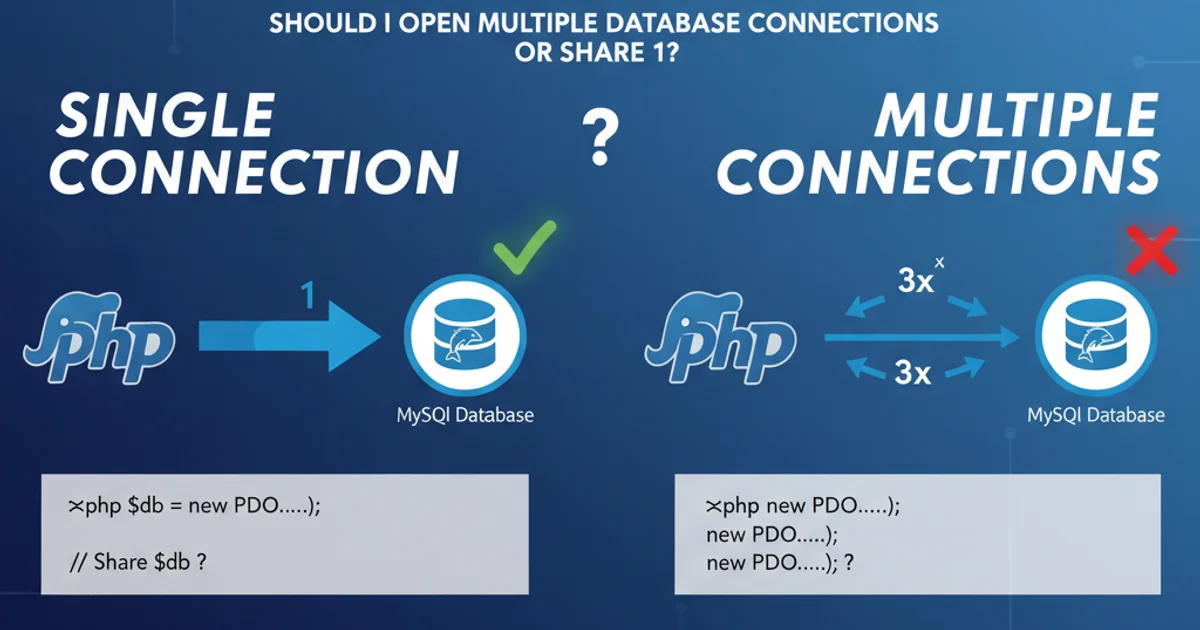In PHP/MySQL should I open multiple database connections or share 1?
Categories:
PHP/MySQL: Single vs. Multiple Database Connections

Explore the performance and resource implications of using a single shared database connection versus opening multiple connections in PHP applications interacting with MySQL.
When developing PHP applications that interact with a MySQL database, a common architectural decision arises: should you establish a new database connection for each query or operation, or should you maintain a single, persistent connection throughout the application's lifecycle? This article delves into the technical considerations, performance impacts, and best practices surrounding this choice, helping you make an informed decision for your projects.
Understanding Database Connections
A database connection is a communication channel established between your PHP application and the MySQL server. This channel allows your application to send queries and receive results. Establishing a connection involves several steps, including network handshake, authentication, and resource allocation on both the client (PHP) and server (MySQL) sides. These steps consume time and system resources.
flowchart TD
A[PHP Application] --> B{Request Received}
B --> C{Database Operation Needed?}
C -->|Yes| D[Establish Connection]
D --> E[Execute Query]
E --> F[Process Results]
F --> G[Close Connection]
G --> H[Return Response]
C -->|No| HTypical lifecycle of a database operation with connection establishment and closure.
The Case for a Single, Shared Connection
The prevailing best practice in most PHP applications is to use a single database connection per request. This connection is typically opened at the beginning of the request and closed at the end. The primary reasons for this approach are:
- Reduced Overhead: Establishing a new connection is resource-intensive. By opening only one connection per request, you minimize the overhead associated with connection setup and teardown.
- Resource Management: MySQL servers have limits on the number of concurrent connections. Sharing a single connection helps manage this limit more effectively, preventing the server from being overwhelmed by too many connection attempts.
- Transaction Management: Managing transactions (ACID properties) is simpler with a single connection, as all operations within a transaction occur over the same channel, ensuring atomicity and isolation.
- Connection Pooling (Persistent Connections): While not strictly 'sharing' in the sense of multiple connections within a single request, PHP's persistent connections (e.g.,
mysqli_pconnector PDO'sPDO::ATTR_PERSISTENT) allow the PHP process to reuse an existing connection to the database for subsequent requests, further reducing connection overhead. However, persistent connections come with their own set of challenges, such as state management and potential resource leaks if not handled carefully.
<?php
// Using a single connection for a PHP request
$servername = "localhost";
$username = "username";
$password = "password";
$dbname = "myDB";
// Create connection
$conn = new mysqli($servername, $username, $password, $dbname);
// Check connection
if ($conn->connect_error) {
die("Connection failed: " . $conn->connect_error);
}
// First query
$sql1 = "SELECT id, firstname, lastname FROM MyGuests";
$result1 = $conn->query($sql1);
// Second query using the same connection
$sql2 = "INSERT INTO MyGuests (firstname, lastname, email) VALUES ('John', 'Doe', 'john@example.com')";
$conn->query($sql2);
// Close connection at the end of the script
$conn->close();
?>
Example of using a single MySQLi connection for multiple operations within a PHP script.
The Pitfalls of Multiple Connections
Opening multiple database connections within a single PHP request is generally discouraged due to several drawbacks:
- Performance Degradation: Each new connection incurs overhead. Opening multiple connections within a single request significantly increases the time and resources spent on connection management rather than actual data processing.
- Increased Server Load: Your MySQL server will have to handle more concurrent connections, potentially leading to resource exhaustion and slower response times for all clients.
- Resource Contention: Multiple connections from the same application instance might contend for resources, leading to deadlocks or inefficient query execution.
- Complexity in Transaction Management: If you need to perform transactional operations across different connections, it becomes significantly more complex and error-prone to ensure atomicity and consistency.
flowchart TD
A[PHP Application] --> B{Request Received}
B --> C1[Operation 1]
C1 --> D1[Open Conn 1]
D1 --> E1[Execute Query 1]
E1 --> F1[Close Conn 1]
B --> C2[Operation 2]
C2 --> D2[Open Conn 2]
D2 --> E2[Execute Query 2]
E2 --> F2[Close Conn 2]
F1 & F2 --> G[Return Response]Inefficient approach: Opening multiple connections for different operations within a single request.
When Might Multiple Connections Be Considered (Rare Cases)?
While generally not recommended, there are extremely niche scenarios where multiple connections might be considered, though often better alternatives exist:
- Connecting to Different Databases/Servers: If your application genuinely needs to interact with entirely separate MySQL databases on different servers within a single request, then multiple connections (one per distinct database/server) are necessary. However, this is different from opening multiple connections to the same database.
- Long-Running Background Processes: In very specific, long-running background scripts (e.g., data migration tools) where a connection might time out, or different parts of the script operate on vastly different data sets with distinct security contexts, one might consider managing multiple connections. Even then, careful resource management and connection pooling are crucial.
Conclusion and Best Practice
For the vast majority of PHP/MySQL applications, the best practice is to establish a single database connection per request. This approach optimizes performance by minimizing connection overhead, conserves server resources, simplifies transaction management, and aligns with how modern web servers and PHP processes handle requests. Leverage PHP's mysqli or PDO extensions, and consider using persistent connections (with caution) or a robust framework that handles connection management for you.